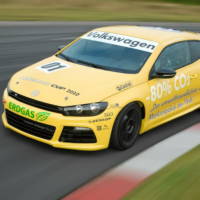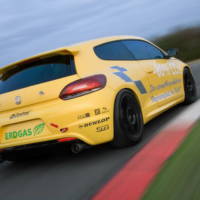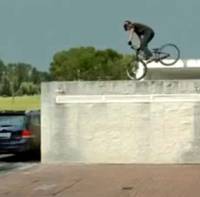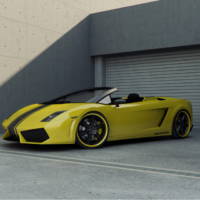Volkswagen announced that it will debut the Scirocco Cup in 2010 as a one-make Bio-CNG-powered race series. The 2010 Scirocco Cup will be the most eco-friendly one-make championship in the world and and the German automaker wants to prove that major innovations are still being made in motorsports.
The Volksagen Scirocco models that will compete in the 2010 Scirocco Cup are equipped with a 2.0-litre 4-cylinder engine providing 223 PS and 203 lb.-ft. of torque, and all the power is put to the ground via a paddle shifter operated 6-speed DSG gearbox.
The first Volkswagen Scirocco to compete in a race was in 1976 in the VW Junior Cup and since then drivers like Niki Lauda, Nelson Piquet or Michael Schumacher have all won a title powered by Volkswagen.
Volkswagen press release :
Following the successful debut of the compressed natural gas-powered Scirocco GT24-CNG at the Nürburgring 24-hour race, Volkswagen is launching a one-make Bio-CNG-powered race series in 2010. With a CO2 reduction of 80 per cent being achieved in combination with Bio-CNG, the Scirocco Cup will demonstrate that major innovative strides are still being made in motorsport and make it the most eco-friendly one-make championship in the world.
The Cup version of the Scirocco is designed to enable eco-friendly motorsport. Based on the TSI unit fitted in the Scirocco, the Bio-CNG-racing version of the 2.0-litre four-cylinder engine develops 203 lbs ft of torque and up to 223 PS. A push-to-pass system provides a short burst of increased power of 30 PS to create additional overtaking opportunities and action throughout the race. Steering wheel-mounted paddle shifts operate a six-speed DSG gearbox and, as with the road-going Scirocco R, power is channelled through the front wheels.
Fitted with a fuel tank with a capacity of 22-litres, the Volkswagen Scirocco Cup uses so-called Bio-CNG which is produced from renewable resources such as grass or a special type of maize as well as from refined biological waste. The fuel tank itself is made from a composite material and is located behind the driver’s seat, protected by the vehicle’s roll cage.
The stainless steel pipes and special valves required for CNG operation within the Scirocco Cup use tried and tested components from Volkswagen production models with CNG engines, and the system pressures of 200 Bar are identical to those of the production vehicles.
Commenting on the new Scirocco Cup, Volkswagen Motorsport Director Kris Nissen explained: ‘By clinching class victory at the Nürburgring we proved that CNG-powered vehicles not only deliver high fuel economy but also allow very sporty driving. That’s why we’re particularly proud about launching the world’s first one-make cup with CNG-powered vehicles.’
Next year, promotion of young talent will again be a top priority and the aspiring racers youngsters will be able to compete with five motorsport legends at each of the races. These legends will come from Formula 1, DTM, rally racing and Le Mans as well as TV and show business.
Volkswagen first raced the Scirocco back in 1976 in the VW Junior Cup and the first winner, Manfred Winkelhock, went on to achieve major exploits in motorsport with Volkswagen. Since then, drivers including Niki Lauda, Nelson Piquet, Keke Rosberg, Bernd Schneider, Tom Kristensen and Michael Schumacher have all won the title "powered by Volkswagen”.
The Scirocco Cup will replace the successful Polo Cup after six years and will become the DTM partner series in 2010.
Technical Data, Volkswagen Scirocco (Cup Version)Engine Type Four-in-line turbo spark ignition engine with CNG-inlet pipe injection, intercooler, four valves per cylinder
Displacement 1,984 cc
Output Approx 162 kW (223 PS) at 6,000 rpm
Torque Approx 203 lbs ft at 3,000 rpm
Engine control unit Bosch MS4
Push-to-pass Electronic charge pressure control, limited duration
and frequency, additional output of approx. 22 kW (30 PS)
Exhaust system Modified layout, racing catalytic converter
Power transmission Gearbox Front-wheel drive, standard six-speed DSG gearbox with dual clutch, steering wheel paddle shifters, modified gear ratio and software, mechanical limited-slip differential
Chassis Front axle McPherson struts, wishbones
Rear axle Multilink rear suspension with uniball joints
Dampers/springs ZF Sachs dampers with H&R springs, one-way adjustable
Anti-roll bars Adjustable H&R anti-roll bars, front and rear
Steering Electro-mechanically assisted rack and pinion steering
Braking system Ventilated 4-piston fixed-calliper disc brakes, front (Æ 356 mm), single-piston sliding-calliper disc brakes, rear
(Æ 282 mm), racing ABS
Wheels ATS light alloy rims, size 9 x 18 inches
Tyres Dunlop 240/640/18 (slick and rain tyres)
Body Body Unitized design, FIA-conformant roll cage, “R-Line” exterior package
Cockpit Volkswagen sport steering wheel with airbag, OMP racing seat with head protector, six-point safety belt, safety mesh net (driver’s side), fire extinguishing system, Aim-Memotec data logging
Dimensions Length/width/height 4,256/1,810/1,380 mm
Track 1,571 mm front, 1,567 mm rear
Wheelbase 2,578 mm
Tank capacity 22 kg Bio-CNG
Dry weight 1,250 kg
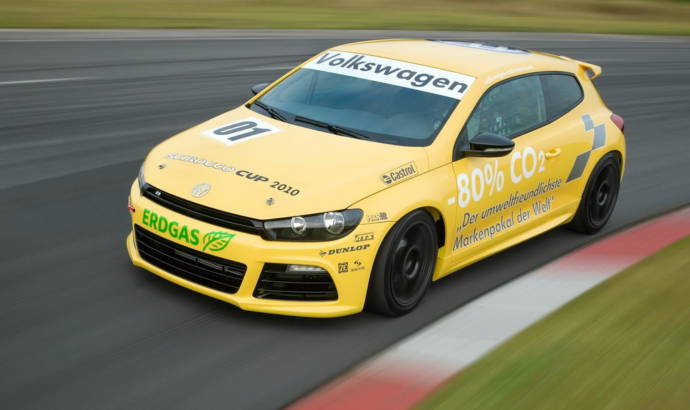
29 Oct 2009
0

